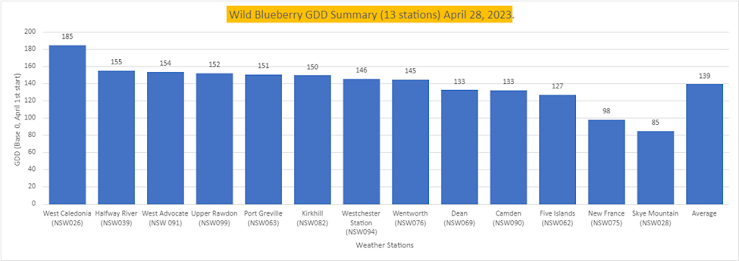Here is another update before the weekend. I know many
growers are planning to put on pre-emergence herbicides in sprout fields this
weekend. Best luck!
In this update, growers can see the GDD summary, April rainfall summary for NS (Ryan Snoddon, CBC), and F2 % in several regions.
Growing Degree
Days (GDD) Summary
Here is a summary of the most up-to-date GDD from 13 weather
stations in wild blueberry fields.
Figure
1. GDD Summary, April 28, 2023
Where are we now regarding plant development in different regions?
Sprout fields
pre-emergence herbicide application: Most of the regions/
sprout fields in mainland NS should start pre-emergence treatments. Many
growers I talked to this week are planning to put chemicals this weekend. According
to wild blueberry plant emergence GDD (213 GDD), growers should get those
products to sprout fields before 200 GDD to avoid crop damage.
Mowing height could also affect plant emergence. If you tend to mow low, the old stems from last year are likely to show early emergence. According to the weather forecast, most of the mainland should start seeing plant emergence after mid-late next week. Ideally, for those areas, herbicide application should be completed before next weekend.
Growers in Cape Breton, Antigonish or any late areas/fields that still have GDD below 100 can wait a few days, but if you want to start this weekend, it is fine. Ideally, after mid-next week should set a starting point for growers in those areas to start their sprout herbicide application.
Lastly, a reminder about
pre-emergence herbicides. What we currently have available and commonly use
pre-emergence spring herbicides are Chikara, Velpar, Ignite, Sinbar, and Spartan.
Be mindful if those products are on your management program this year.
Crop fields monilinia
blight season: we are walking into the monilinia blight
season. Please see the below table for % F2 in different regions according to
weather station GDD, personal observation and communication with growers.
If you notice your fields
are at and above 40% F2, I expect growers to check their local weather forecast
and make an application plan for crop fields before any long wet periods.
I am guessing Antigonish
and Cape Breton crop fields are looking at about 1 week to get to 40% F2 GDD
(173 GDD), so growers in those areas should start monitoring after next
weekend.
I still want to remind everyone that after fields reach 40% F2 and above, a Monilinia blight application should be made before a forecasted wet/rainy period. But, if it is forecasted to be a dry period, then an application can wait until before a new wet period. After the first application, those chemicals should give plants 7-10 days of protection.
April is going to be a very dry month in NS. With only two days left in this month, it is unlikely to catch up on average. (Figure 2).
Figure
2 April Rainfall (CBC)
Wild Blueberry Floral
Bud F2 Stage
Please see the below summary table of the percentage of
wild blueberry floral bud at the F2 stage. You can also click on this map to
check those numbers. Detailed information is also available under the Wild Blueberry
Blog- GDD&
Phenology Tracker.
Table 1. Percentage of Wild Blueberry Floral Bud F2
stage
light green (0-20% F2), dark green (20-30% F2), yellow
(30-40% F2) and red (40-100% F2)
|
Wild blueberry production regions, NS |
The average percentage of floral buds at
F2 |
|
|
|
|
Cape
Breton |
0-5%-
April 28 |
|
|
|
|
Antigonish
County |
5%-
April 28 |
|
|
|
|
Pictou
County |
10%-
April 28 |
|
|
|
|
Guysborough
County |
8-10%-
April 28 |
|
|
|
|
HRM
(Dean, Musquodoboit…) |
30%- April 28 |
|
|
|
|
Colchester County |
|
|
Camden |
33%-
April 27 |
|
Greenfield |
25%- April 27 |
|
|
|
|
Cumberland County |
|
|
Halfway River |
51%- April 28 |
|
Kirkhill |
35%-
April 27 |
|
Westchester Station |
10%- April
27 |
|
Diligent River |
5%- April
28 |
|
Port Greville |
30%- April 28 |
|
Wentworth |
20%-
April 27 |
|
|
|
|
Hants County |
|
|
Upper Rawdon |
30%-
April 27 |
|
|
|
|
South West Nova Scotia |
>40%, watch the weather
forecast and prepare for spraying |


